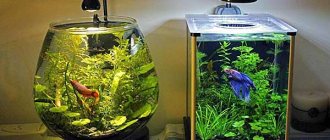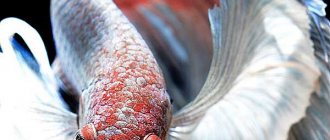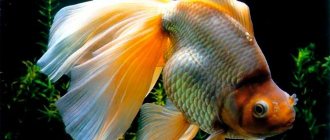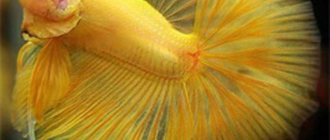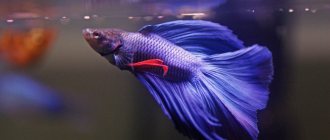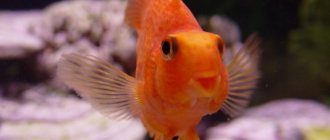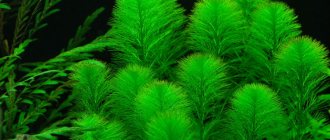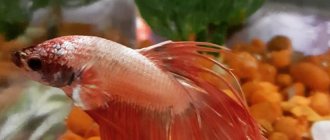Content
- 1 Description of Petushkov
- 2 Types of cockerels
- 3 Behavior and neighbors for cockerels
- 4 Decorating an aquarium for a betta
- 5 Conditions for keeping a cockerel
- 6 Food
- 7 Reproduction 7.1 Caring for the offspring of cockerels
Betta fish: one of the most popular and beautiful aquarium fish.
- Other names: Siamese cockerel, Betta splendens, Siamese Fighter, fighting fish, cockerel fish.
- Origin: Small ditches and temporary reservoirs of mainland Southeast Asia.
- Size: up to 7 cm.
- Temperature: 24-28 °C.
- Water parameters: pH 6-8, dGH 5-15 °.
- Behavior: males are warlike towards males of the same species.
Description of the species
This fighting fish came to us from Southeast Asia, where it lives in large numbers in small streams and rice fields. Of course, the fish there are significantly inferior in appearance to the modern variations that appeared during a long and painstaking selection. But the homeland of this unsurpassed species of fish is there.
The cockerel belongs to the Labyrinth family, to the genus Betta. There are several dozen subspecies of them, which differ from each other both in appearance and in the degree of aggressiveness. In Latin, betta fish are called Betta splendens.
Cockerel fish in an aquarium
Males are brighter than females and larger; in an aquarium they will be its decoration. Females of this species have shorter fins and a faded coloration, although in recent decades fish have been bred in which the females are brightly colored. But against the background of males they will look inconspicuous.
The color of the fins can range from gray to deep blue, and their shape depends on the specific species. Thus, the veil-tailed betta is significantly larger in size than the shorter fin-shaped variations, and looks great in the aquarium. The average size of betta splendens is 5–6 cm, with females being slightly smaller.
Description of Petushkov
Betta fish
- one of the most popular ornamental fish, which makes these fish frequent victims - not understanding how, in principle, to keep bettas in home aquariums, beginners kill them in the thousands. Breeding of Betta splendens has been carried out since the end of the 19th century, aimed at improving the color and shape of the fins. Decorative specimens can vary greatly in color, shape and length of fins. The coloring becomes brightest during spawning and during a fight with an opponent. The body is most often teardrop-shaped, slightly curved, thickening towards the head. The fins, depending on the species, are large, veiled and crown-shaped, and are two or more times larger than the fish itself.
The name “cockerel” has stuck to all varieties of Betta, but this is not entirely correct; only betta splendens should be called cockerels!
Description
Fish have a long history of being kept in artificial aquarium environments. During this time, many breeding forms were developed, very different from each other and completely different from their wild relatives. A common feature is an elongated, strong, cylindrical body. The fins and tail of some species can reach impressive sizes. The colors are very varied: red, blue, white, etc.
Classic species have also been preserved, outwardly no different from those that can be seen in the swamps of Sumatra or the forest streams of Borneo. Unlike the selection varieties, their coloring is not so bright and varied.
Like Gourami, they have an additional respiratory organ - a labyrinthine organ, which got its name because of its unusual structure, reminiscent of a blood labyrinth, penetrated by many capillaries. It is designed to capture atmospheric oxygen when the fish rises to the surface and swallows a bubble of air. This adaptation helps to survive in dirty, muddy water depleted of oxygen.
Behavior and neighbors for cockerels
Bettas, also known as Siamese fighting cocks, have become popular among fish enthusiasts primarily because of the males' beautiful colors and gorgeous fins. Several females can be placed in an aquarium with peaceful fish, the main thing is that there are no fin pluckers among the neighbors; some characins and barbs can leave the bettas plucked and in a state of stress.
They are slow, and in a community of large, mobile fish they spend most of their time in shelters. It is best kept in a small species aquarium. If several males get into the aquarium, they will start constant fights, which will most likely end in the death of the weak ones. There are relatively peaceful species, the males of which do not cause serious injury to each other. However, “cockerels” are very peaceful with other fish: small characins, peaceful barbs, and viviparous fish.
Only one male can live in one aquarium; peaceful neighbors are also suitable for them as neighbors: corydoras, loaches, zebrafish, tetras, non-aggressive and small barbs. Otherwise, the males will attack each other, the stronger one will chase the weaker one, tear off the fins and, most likely, kill the opponent.
Cockerel fish: maintenance and care at home
Compatibility of cockerels with other fish
Beginning aquarists often wonder who the betta fish gets along with. In a small aquarium, there will be a constant struggle between its inhabitants for territory, and any neighbors of the warlike Siamese cockerel will inevitably suffer.
A male betta fish will definitely attack other males and sometimes even females, so the male should be kept in a separate aquarium. In another aquarium you can place 3-4 females: they are calmer, but fights between them are not excluded. If you notice signs of aggression on the part of one of the females, it is better to move her into a separate tank.
Aquarium betta fish are not compatible with the following fish:
- Cold-loving fish (eg goldfish). Cold-loving species need colder water than bettas.
- Brightly colored fish with long fins. The bright colors of “competitors” irritate the bettas.
- Predatory and large fish (for example, African and South American cichlids, piranhas, lineatus, acara).
- Small fish up to 5 cm in length.
- Fish that cannot live without dissolved oxygen (in the absence of aeration in an aquarium with bettas).
- Guppies, barbs, cardinals.
The aquarium betta fish gets along well with the following fish:
- Speckled catfish,
- Tetra,
- Danio,
- Neon,
- gourami,
- sword bearer,
- Molliesia,
- Pecilia,
- Ancistrus,
- Neon rainbow,
- Otocinclus,
- Acantophthalmus,
- Minor,
- Ornathus,
- Pulkhripinnis,
- Rubrostigma,
- Ternetia,
- Rasbora,
- Congo,
- Botsia,
- Brocade catfish,
- Tarakatum,
- Sturisoma,
- Loricaria,
- Platidoras,
- Befortia,
- Gastromizon,
- Macrognathus,
- Siamese algae eater.
The compatibility of males with other fish is shown in the table below.
Female betta fish, which do not have luxurious fins, most often get along well with any type of fish.
Also note that the minimum tank volume for one betta is 5 liters. If there is less water, the cockerel will fight with its neighbors. At the first sign of aggression, the aquarium betta should be moved to another tank.
Some aquarists choose a large aquarium separated by transparent partitions, which allows them to keep several male bettas without compromising their health.
Water, soil, water temperature in the aquarium
Keeping betta fish at home and caring for them is not so difficult, because the betta fish is extremely unpretentious: gravel or river sand is suitable for it as soil. It is better to filter the water, and to prevent diseases, use special salt, which is purchased at aquarium stores (0.5 tsp per 3 liters of water). In large aquariums, water is changed every 2 weeks, in small aquariums - every 3 days. Aeration is not so important for labyrinth fish, but a low-power filter is required. The optimal water temperature for keeping aquarium bettas is + 24-28 degrees.
Photo by: platonpro100
Vegetation in an aquarium for a betta
Aquatic plants should occupy a third of the area of the aquarium; they are planted directly in the ground or in special containers. One of the most popular aquarium plants is Java moss, which is also suitable for spawning. Any decoration of an aquarium for a betta with driftwood, grottoes and all kinds of shelters that are environmentally friendly and devoid of sharp fragments is welcome.
What to feed your betta fish?
The aquarium betta fish is prone to obesity, so overfeeding it is not recommended. Betta fish should be fed 1-2 times a day, and the amount of food should be given exactly as much as the fish can eat in 15 minutes. Food can be live, dry or frozen. Remains of uneaten food are removed.
Zooplankton, bloodworms, tubifex, artemia, daphnia, and earthworms are used as live food for cockerels. Dry food is available in the form of flakes and granules, created specifically for bettas. To avoid gastrointestinal diseases and excessive water pollution, preference should be given to live and frozen food.
Decorating an aquarium for a betta
An unacceptably small aquarium for a Cockerel
It is best to place cockerels in an aquarium moderately decorated with plants, stones and snags. Avoid any rough edges or gravel with sharp edges. It is better to place plants on the sides and at the back wall; it would also be appropriate to have floating plants. This fish is an excellent jumper, so covering the aquarium is necessary. This is a labyrinth fish, which means it breathes air. Do not cover the aquarium with a blank lid or spray insect repellents or other aerosols near the aquarium.
We have an article Aquarium for bettas for beginners in this matter.
Some tips
A cockerel that was not kept properly before spawning, that is, it was not fed enough, can eat caviar. The same behavior is observed in young fish that were first placed for spawning. In the future, this goes away in most individuals.
Cockerel fish
When buying fish, you should not choose the largest and brightest individuals, this indicates their age. The larger the cockerel, the older it is, which means it will live less and may not produce healthy offspring.
Aeration should not be turned on in the spawning tank; it can ruin the entire breeding process. The male himself makes bubbles for the nest from the air, and actively purging the water with oxygen will only disturb him.
In an aquarium containing fish with veil fins, there should be no objects with sharp edges that could damage their long fins. Therefore, it is better to refrain from decorating the bottom with different castles and grottoes.
This species is one of the most successful in terms of selection; many colors and fish with different fins have been bred. The table of contents of books on the selection of aquarium species necessarily includes the genus Betta.
Conditions for keeping a cockerel
Although these fish can live for a long time in small volumes of water, for a comfortable and healthy life they need containers of 20 liters only for a betta, without taking into account neighbors. This type of aquarium fish loves clean water, so frequent water changes are necessary. It’s good to pick up a small piece of driftwood for such an aquarium - a piece of driftwood made from mangrove wood sinks quickly and is convenient to use. Of course, it colors the water, but the rooster really likes it, since the driftwood releases humic substances into the water, and the rooster loves this kind of water.
There is a misconception that a betta can be kept in very small quantities!
Only professionals can keep fish in small containers, and even then not for long. Yes, the fish does not use oxygen from the water, but in all other respects it is the same fish. And the most common mistake of novice aquarists is to put a cockerel in a bare five-liter round aquarium, completely change its water once a week or a week and a half, and thereby expose the fish to constant stress!
Cockerel reproduction in an aquarium and the difference between a male and a female
The Cockerel fish reaches maturity at 3-4 months. The distinctive features of a male from a female are distinguished by several characteristics:
- brightness of color. Females are smaller, their coloring is more modest, and their fins are smaller. The abdomen is slightly rounder;
- fin size. Males have a larger (longer) fin.
A white dot near the anal fin of a female betta means the female is ready to spawn. And she is also “putting on weight.” Before breeding, it is recommended to include bloodworms in the diet - this is how to ensure that the eggs become soft.
To stimulate spawning, slightly increase the water temperature to approximately +26-30 ° C and soften the water. To soften the water, you can add special pH-lowering agents, which can be purchased at a pet store. An aquarium for spawning is suitable from 10 liters, the height of the walls of the aquarium (spawning tank) should be 15 cm. Also, the female must be able to hide from her partner, so small shelters are made in the spawning tank and plants are planted. We also need plants that float above the water; this plant will serve as a place for a nest.
The female and male are removed from a common aquarium into a spawning tank for a day, where the male builds a nest with the help of saliva and bubbles. During spawning, the male helps the female squeeze out eggs, which he places in the nest. When all the eggs are in the nest, the female from the spawning tank must be returned back to the aquarium. The male stays with the eggs until the eggs hatch into the fry. The spawning area must be illuminated around the clock so that the male can collect eggs that have fallen from the nest. After the fry hatch, the male from the spawning tank must be returned to the aquarium so that he does not eat the fry.
Newborn cockerels are fed with ciliates and ground yolk, and a little later with special food, crushed tubifex, and Artemia nauplii.
Females must be allowed to spawn. If the female does not spawn, the eggs may turn into a tumor, and the fish will die.
Nutrition
It is good to feed cockerels with live food: bloodworms, tubifex, chopped earthworms, brine shrimp. They also eat flakes and freeze-dried food, especially specialized food for bettas. Different brands have separate lines of food that support the color of bettas. Do not overfeed the fish. Betas are not very active fish and like to hang in place for a long time, which significantly saves them energy. If the cockerel lives alone, then you should feed it in very small portions, making sure that he eats everything. If the food falls to the bottom, it means the fish is full and you should take a break from feeding for 1-2 days. This will only improve your pet's health.
Nutritional Features
Betta fish require a balanced diet, which is easy to provide at home. It should be based on frozen food (bloodworms, brine shrimp, daphnia) and specialized mixtures sold in pet stores. Do not overfeed your pets, otherwise the water will quickly spoil. In addition, overfeeding can lead to obesity, and as a result, a reduction in life expectancy. A male cockerel may also lose the ability to reproduce.
Betta cockerels happily eat live food, but you need to be extremely careful here. After all, pathogenic microorganisms can also enter the aquarium along with them, as a result of which the betta fish can get sick and die. In a separate article we look at popular diseases of betta fish.
The filtration system will help remove fish waste, as well as food residues. With its help, caring for your betta fish will be really simple. The main thing is not to forget to clean the filter on time so that the accumulated pieces of debris in it do not fall back into the water.
Well, the last thing worth adding about feeding: food for a betta should not be too large, the fish should swallow it easily.
Reproduction
Male cockerel squeezes eggs from female into nest
If you decide to breed bettas, then, of course, you will have to keep the pairs in different aquariums. Spawning grounds should not contain devices that can destroy the foam nest, such as, for example, aeration or strong filter pressure.
After the courtship period, the male begins to build a nest in the foliage of floating plants. The male and female become entwined and the eggs fall onto the male's anal fin. He will swim away from the female and the eggs will fall to the bottom. The male collects the eggs in his mouth, covers them with saliva and carefully “spits” them into the foam nest.
The female initially participates in placing the eggs in the nest, but soon the male drives her away, taking care of the offspring himself. At this time, the female should be removed from the aquarium before the male causes her serious harm.
After about 5 days, when the fry begin to swim freely, the male should also be removed.
Caring for the offspring of cockerels
Next, the male takes care of the nest - he eats dead eggs and renews the nest. There is no need to feed him at this time, and there is no need to change the water either. After a day, the larvae begin to hatch. At first they hang in the nest, the male continues to look after them, after a day their yolk sac usually dissolves and they begin to swim horizontally - at this moment you need to remove the male and turn on the compressor. Then the first feeding is done - we feed ciliates, if there are none, then you can feed them with food like Sera micron; I don’t recommend boiled egg yolk or boiled liver - they greatly spoil the water. You need to feed so that there is always food in the aquarium. There is no need to change the water. Gradually, over the course of a week, the temperature in the aquarium should be reduced to room temperature. After 3 - 4 days, the fry begins to take the nauptile of the artemia, but we do not stop feeding the ciliates - the smaller fry still eat it. If there is no brine shrimp, you can feed both decapsulated brine shrimp and dry food like Sera micropan. After a week or a week and a half, you can offer the fry frozen microplankton, and later - cyclops, cut tubifex. As soon as the fry begin to eat brine shrimp, you can gradually raise the water level, and later change the water. If you feed dry food - daily, if live - less often. When the fry reach a size of 1 cm, if you want to grow more fish, the fry need to be sorted into different aquariums, otherwise the larger fry will eat the smaller ones. Then it is advisable to transfer the fish to a larger aquarium so that they do not drag on. When the fish begin to identify by sex and fight, you need to seat the males in separate containers, and it is better to feed the fish in them with live food. By the age of three months, cockerels are usually fully colored, with some exceptions; males begin to train in nest-building, and they can be placed for spawning at 4-5 months.
Cockerel compatibility
Aquarium betta fish and caring for them, although simple, require certain knowledge. In particular, the issue of compatibility of betta splendens with other species is particularly acute. After all, incorrectly chosen neighbors can pay not only with their fins, but also with their lives. Due to its fighting nature, this ornamental fish requires a careful approach in this matter.
Experts recommend keeping fish of this species in a so-called species aquarium, where one male and 2-3 females or two or more males will swim. Although the aquarium betta is considered an uncooperative species, with the right approach it is possible to reconcile such neighbors in the same aquarium. To do this, the fish must first be separated by a partition, which is then removed, or several fish are taken from the fry and raised together in a spacious aquarium. But there is always a risk that the fighting characteristics of these fish will make themselves felt.
We figured out how to care for cockerels, but we haven’t considered all the potential neighbors for them. In a large aquarium, peaceful coexistence with swordfish, mollies, speckled corydoras catfish, rasboras and a number of other species is possible. Neighborhood with cichlids, barbs, labeos and gouramis is undesirable; this can result in both torn fins and the death of the fish.
Cockerel fish and catfish
In general, rooster fish, care and maintenance in a common aquarium imply the absence of neighbors with veil fins, so never put guppies, goldfish and bettas in the same container. Nothing good will come of this.
The only representative of the species that is absolutely not aggressive towards other inhabitants of the aquarium is the black cockerel. But it is not as widespread as the usual one.
Breeding
The betta fish reaches sexual maturity at about three or four months. For spawning, a separate large aquarium of 10 liters is required.
In the spawning area, shelters are made from aquarium plants and decorative grottoes. This is necessary so that the female has the opportunity to hide from the male betta fish, he becomes very aggressive.
Spawning must be stimulated by changing the water in the aquarium and by slightly increasing the water temperature, by about 1 - 3 degrees. The fish are first allowed to get used to and get to know each other. They are placed in different vessels so that they can see each other. Small floating plants necessary for the male betta are added to the aquarium so that he can make a nest.
At the beginning of spawning, the male builds a nest. He blows air bubbles and seals them with his saliva. When spawning, the male picks up the eggs with his mouth and puts them in the nest.
At the end of the spawn, the male drives away the female betta fish and guards the offspring himself. He guards his nest, collects fallen eggs and puts them back, and when the larvae hatch, he prevents them from scattering around the aquarium and collects them back into the nest. The female that provided the eggs is removed from the aquarium.
At one time, a female betta fish lays from 100 to 300 eggs. If everything is done correctly, then the spawning of males begins one or two days after the pair is placed in the spawning aquarium. It happens that the time increases and it takes about six days. The betta larvae will appear in a day, two or three. When all the larvae appear, the male must be transferred to another aquarium.
Air for betta fish
The labyrinth organ of this fish is not an addition to its gills; it needs air to breathe. It is extremely important to have a clean water surface, without thickets. The bacterial film that appears on the surface of the water must be removed.
This can be done using a sheet of paper, placing it on the surface of the water. Then carefully remove it. The betta fish is a good jumper, for this reason the presence of an aquarium lid is mandatory. If it is not there, then you need to equip the aquarium with a protective net. And remember, air must pass through the lid. The cockerel fish breathes atmospheric air .
Water for fish
- Soft.
- pH neutral.
The water must be changed periodically. About a third once a week, and in small aquariums (less than five liters) a complete water change must be done every three days.
Tap water that has stood for a couple of days works well. Before adding the prepared water to the aquarium, it must be heated to the temperature of the aquarium water. To defend the water, you can use special preparations that remove bleach. For example, Tetra AquaSafe.
Be sure to remove uneaten food from the aquarium with bettas. As it decomposes, it poisons the water. For these purposes, you can use a siphon or a regular watering hose.
Sometimes it becomes necessary to wash the aquarium completely. For these purposes, it is advisable not to use household chemicals. I clean the aquarium with a regular dishwashing sponge. Its rough surface removes aquarium algae from the walls well.
If the aquarium for the betta fish is not large, then transfer the fish to another body of water. It is better to take water from the aquarium where the fish lives. You need to catch a cockerel with a net made of soft fabric.
Types of betta fish
The long work of breeders has made this fork numerous and varied. The betta fish varies in size and shape of its fins:
- Crescent-tailed
- Veiled tails
- Twin-tailed
- Crown-tailed
- Brushtails
- Flagtails
- Poster
- Giant or royal
- Delta tails
- Round-tailed
There are differences in betta fish by color:
- Multi-colored - the fins and body of the fish can be any color.
- Two-colored - these fish have fins and tail of one color, and the body of another.
- Monochromatic - cockerels, completely painted in one color.
